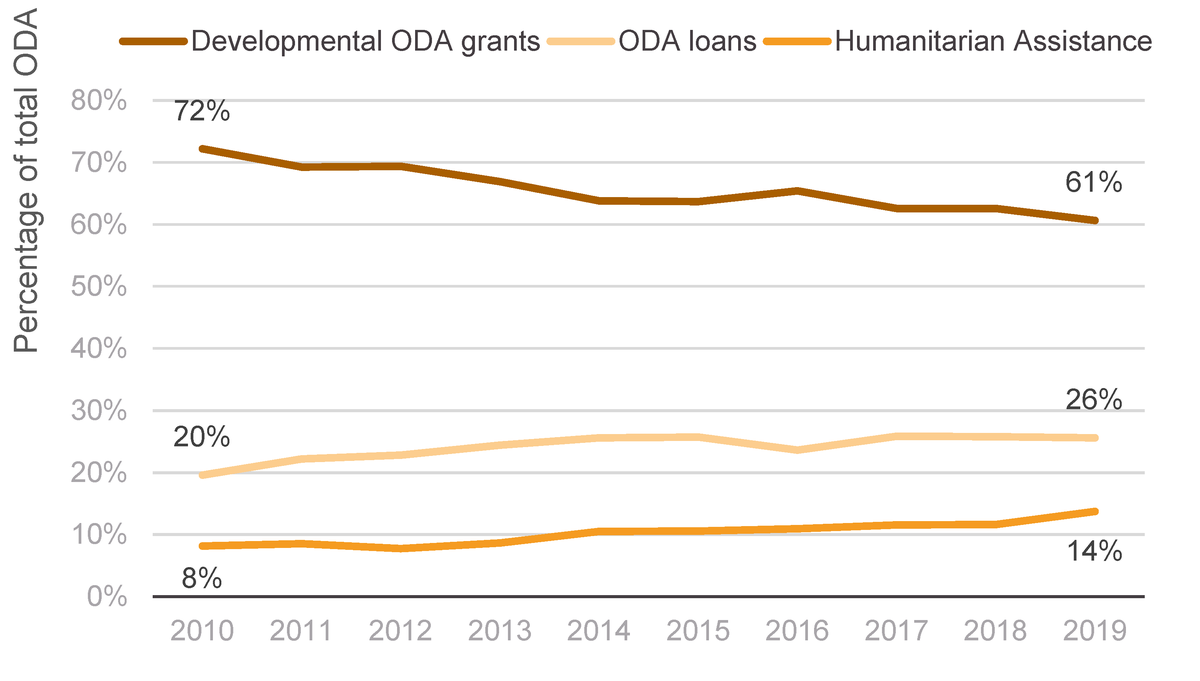Aid data 2019–2020: Analysis of trends before and during Covid
What key shifts in donors, sectors, targeting and loans during the Covid pandemic are highlighted by new DAC data on 2019 ODA and 2020 aid figures from IATI?
DownloadsJump to the key findings
Introduction
This briefing looks at trends in aid from the OECD DAC’s full release of official development assistance (ODA) data for 2019, which tells us what was happening to aid right before the Covid-19 pandemic hit. These trends are contextualised with the most recent IATI data (January to November 2020), which tells us how these trends have shifted in 2020 as the impacts of the coronavirus crisis unfold.
Previous DI analysis of the possible effects of the pandemic on aid identified areas of concern, including most notably the risk of a substantial cut to ODA in 2020, a concern which has now become a reality. Before the pandemic, the world was already off track to meet the Sustainable Development Goals and there is no question that this crisis has pushed us even further off track.
With the economic and health impacts of the Covid-19 pandemic compounding worrying trends in aid, the world faces an unprecedented challenge and one that will have serious development effects. The pandemic has exacerbated existing concerns about the economic outlook both globally and for developing countries specifically. [1]
The pandemic has driven the greatest economic recession since the Great Depression – with the International Monetary Fund forecasting in October 2020 that global growth would have declined by almost 5% in 2020, [2] and that was before the renewed lockdowns and downturn seen at the end of last year.
The picture is more challenging for poorer countries as progress is reversed while poverty and inequality rise. Our analysis shows that, in 2020 alone, extreme poverty was set to increase by 2.5% on average across low-income countries (LICs), with extreme poverty levels in Sub-Saharan climbing to 43%. [3]
Developing countries face sustained and growing challenges in financing development. Our projections show developing countries are set to lose almost a trillion dollars in 2020, a loss that will be sustained for many years to come. Debt ratios in the least developed countries (LDCs) had already more than doubled in the last decade and the current Covid-19 crisis is projected to further exacerbate that challenge in all LICs.
Expected falls in foreign direct investment, remittances, tourism receipts and government revenue to LDCs (US$62.8 billion) are larger than total ODA to LDCs (US$57 billion) in 2019. [4] In this context, as developing countries face multiple and overlapping economic, health and social crises sparked by the pandemic, understanding what is happening to ODA is critical.
ODA is a vital resource for supporting those most in need and countering these negative trends. Making the best use of this resource will be fundamental to mitigating the worst effects of the current crisis and hopefully promoting renewed progress towards achieving Agenda 2030.
The first section of this briefing provides analysis of the major global trends in aid which show both a historic flatlining of ODA growth followed by a sharp decline in aid as the crisis hit. This section also looks at the shifting balance of aid from grants to loans, despite the concerns of a growing debt crisis. In section two, the briefing then looks at developments in individual donor countries and how aid from international financial institutions (IFIs) and multilateral organisations has evolved into 2020 . Section three assesses changes in the sector allocation and policy focus of aid – looking at allocation to vital areas including health, humanitarian response, gender equality and climate change. Finally, section four assesses the targeting of ODA , including allocations to LDCs, as well breakdown by country poverty and income levels.
Note
About the data in this paper
This briefing brings together data from the OECD DAC (figures in yellow), which provides complete and verified ODA data, and therefore an important and detailed picture of what has been happening to aid. OECD DAC data is, however, published at least a year in arrears, meaning that the latest detailed data available is up to 2019.
In the current context, what is happening now is of paramount importance to better inform policy and decision-making. For that reason, this briefing also uses the near real-time aid data published to the International Aid Transparency Initiative (IATI) (figures in blue) to deliver more current analysis of what happened in 2020.
IATI data is by necessity limited to the data that is published to a sufficient standard and in a timely enough fashion, so it cannot provide a comprehensive picture of all donors. However, IATI data has reached a sufficient level of quality and coverage to enable critical analysis of near real-time trends, providing a vital early warning system on current aid spending.
In this briefing, we use the term ‘aid’ as per its use in IATI data though ODA is a key focus of analysis. In this context, aid incorporates all humanitarian and development assistance, including ODA (as defined by the OECD DAC) , other official flows (OOFs) and any other development flows reported by official actors to IATI.
The full list of agencies and actors covered in the IATI data used to produce this briefing is available in Appendix 1 . For more information and a full methodology see the note and methodology presented in How is aid changing in the Covid-19 pandemic?
As the full 2020 IATI data becomes available, Development Initiatives will be producing in-depth analysis of what has happened to aid in 2020 during the pandemic.
Key findings
ODA has largely flatlined since 2016, with slight growth in 2019 to US$154.5 billion (Figure 1) – but 2020 shows a marked decline in ODA from bilateral donors (Figure 2) .
Between 2018 and 2019, ODA grew 0.7%. However, comparing 2020 to 2019 (the same January to November period), ODA commitments from bilateral donors fell by 26%, while ODA commitments from IFIs increased by 189%. This increase from IFIs will be unsustainable beyond the short term without substantial new contributions from bilateral donors.
ODA grants are shrinking in significance, while ODA loans have continued to grow (Figure 3) – a trend that accelerated dramatically in 2020 (Figure 4) .
ODA provided in the form of loans increased from 20% to 26% between 2010 and 2019 – a 68% increase in volume – while ODA provided in the form of grants fell from 72% to 61%. This trend is strengthening in 2020 as IFIs play a more significant role. For the period January to November, IFIs provided US$40 billion more in concessional loans in 2020 than they did in 2019.
ODA levels remained steady across individual bilateral donors in 2019 (Figure 5) – but the economic effects of the pandemic saw 4 of the 13 bilateral donors analysed report falls in aid of over 40% (Figure 6) .
Among IFIs and multilateral organisations, the World Bank’s International Development Association and UNICEF reported the most significant increases in ODA between 2018 and 2019, at US$3.9 billion and US$4.3 billion respectively. Overall, 7 of the 13 bilateral donors included in the analysis of IATI data (January to November) reported falls in aid commitments between 2019 and 2020. Limited data from multilateral organisations shows a modest 1.9% increase in commitments from 2019 to 2020, the vast majority of which is concessional ODA.
Humanitarian ODA saw the largest increase in 2019 by US$5 billion (Figure 7) – but 2020 saw a sharp refocusing on health, social protection and other social sectors, particularly from IFIs (Figure 8) .
Bilateral donors in 2020 maintained commitments to health but at the expense of other sectors including humanitarian assistance and governance and security, while IFIs increased commitments across the board with a significant focus on governance and security, social protection and education.
ODA primarily targeting gender equality (Figure 9) and climate change (Figure 10) remained steady, at approximately 5% and 11% respectively, between 2015 and 2019.
ODA to projects with gender equality as a purpose, either as a principal or significant focus, has increased in the last five years from 34% in 2015 to 42% in 2019. Similarly, the proportion of ODA where climate change is considered grew from 20% in 2015 to 26% in 2019. However, IATI data (January to November) in 2020 suggests a decline in focus on climate change.
The proportion of ODA to projects with a significant focus on climate adaptation or mitigation fell from 25% in 2019 to 17% in 2020, while ODA to projects with climate as a principal objective fell from 18% to 14%. IATI data shows a more mixed picture for gender, with ODA principally targeting gender equality rising from 8% in 2019 to 10% in 2020, but significant targeting dropping from 58% to 55%.
ODA to LDCs increased in 2019 by 12% (Figure 11) , while the distribution across income groupings remained steady (Figure 13) – but in 2020 IFIs decreased the proportion of aid commitments to LICs (Figure 15) .
There was little change in the distribution of bilateral aid commitments by country income groupings in 2020. Equally, bilateral donors reported a US$10 billion drop in commitments to LDCs in volume terms but maintained the proportion at roughly half of country-allocable ODA. Conversely IFI commitments to LDCs have fallen proportionally from 59% to 41% but grown in volume by US$11.1 billion.
Targeting of ODA to countries with the highest poverty rates improved in 2019 – with the 12 countries where more than 50% of the population live in extreme poverty seeing a 17% increase from 2018 (Figure 12) – but IFIs reduced the proportion of ODA to countries with high extreme poverty rates from 53 to 33% in 2020.
The increase in targeting of ODA to countries with the highest poverty rates in 2019 represents a US$3.1 billion growth in volume terms over 2018. Bilateral donors maintained the proportion of ODA in 2020 to countries where over 20% of the population live in extreme poverty, at just over half, while IFIs increased the proportion to countries with lower levels of extreme poverty (less than 5%) from 23% to 41%, a US$18.3 billion increase. The significant growth in ODA commitments from IFIs in 2020 meant that the proportional decline to countries with high extreme poverty rates still represents a US$8 billion increase in volume terms.
Global aid trends
ODA grew by a modest 0.7% in 2019 to US$154.5 billion
Figure 1: ODA from DAC donors, 2010–2019
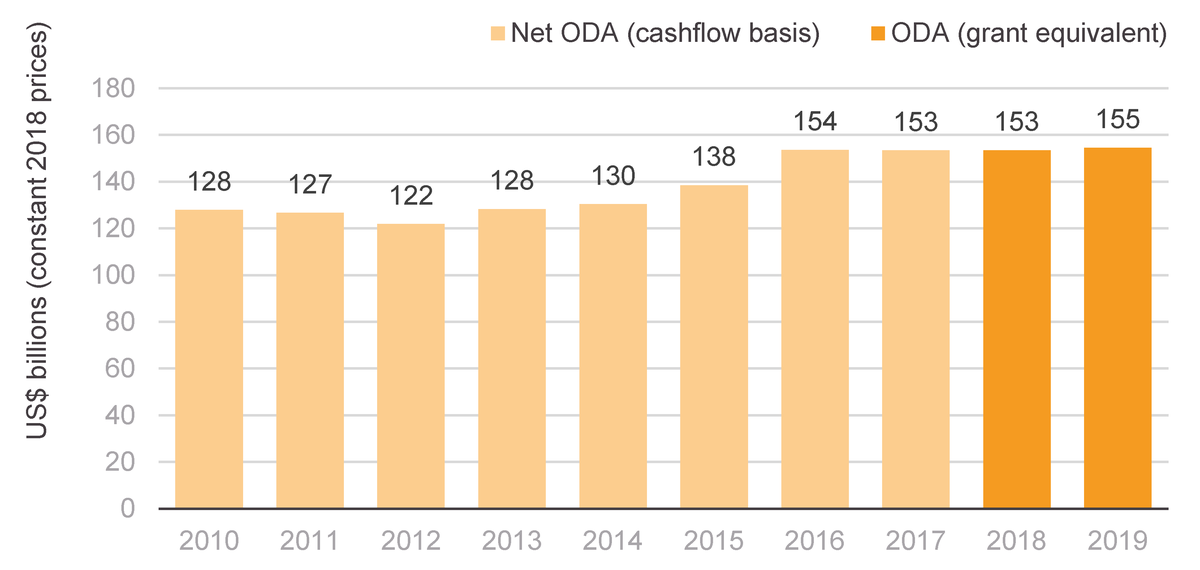
Bar chart showing that ODA grew by a modest 0.7% in 2019 to US$154.5 billion.
Source: Development Initiatives based on OECD DAC data.
Notes: This chart shows net ODA and grant-equivalent ODA for the years in which they respectively represented headline ODA. The difference between the old (net ODA) and new (grant-equivalent ODA) measure is the way that ODA loans are accounted for: under the old measure the full-face value of the loan was reported with loan repayments subtracted; under the new measure only the grant-equivalent of the loan is reported (and loan repayments are not subtracted). Grant-equivalent ODA from DAC donors shown in Figure 1 is lower in volume terms between 2018 and 2019 than gross disbursements from DAC donors and multilateral organisations combined. This means that some of the categories such as sectors in subsequent figures show larger volume increases than could be derived from the grant-equivalent ODA shown in this figure.
- Using the grant-equivalent ODA measure, total ODA increased by US$1 billion (or 0.7% in real terms) between 2018 and 2019. The 2019 level represents an all-time high of US$154.5 billion.
The economic impacts of Covid-19 are driving substantial declines in ODA from bilateral donors in 2020, while commitments from IFIs are growing significantly
Figure 2: Aid commitments by key bilateral donors, IFIs and multilateral institutions, January–November during 2019–2020
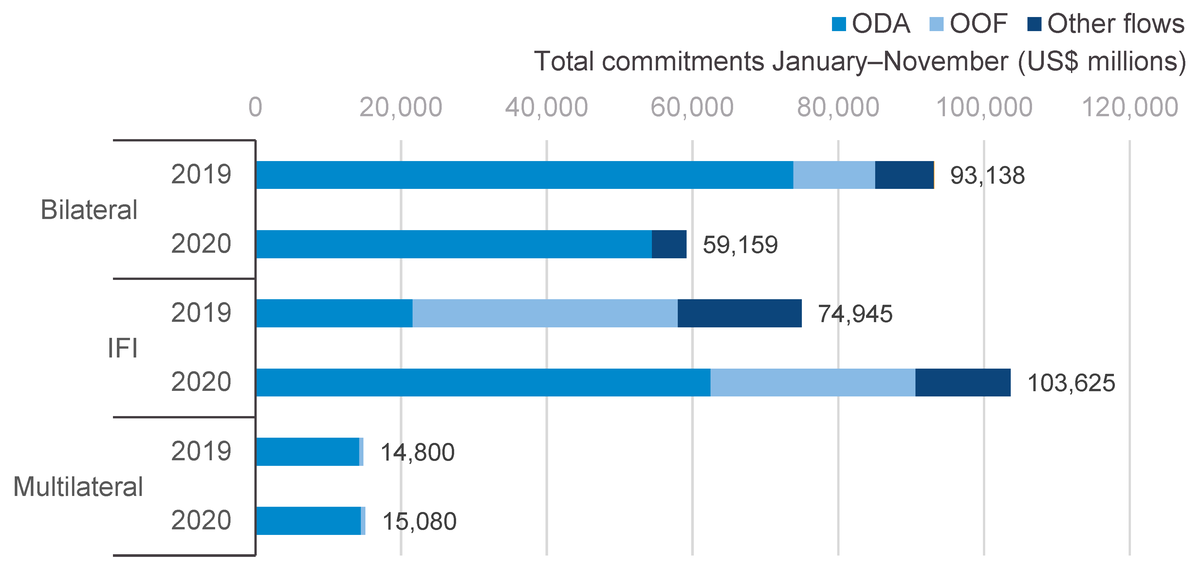
Stacked bar chart showing aid commitments by key bilateral donors, IFIs and multilateral institutions, January–November during 2019–2020.
Source: Development Initiatives based on IATI data.
Notes: IFI = international financial institution; OOF = other official flows. See our briefing 'How is aid changing in the Covid-19 pandemic?' - Table A1 for the full list of bilateral donors, IFIs and multilateral institutions and Table A2 for the full list of flow types included in this chart. Available at: /resources/how-aid-changing-covid-19-pandemic/#section-1-8
- Aid commitments from bilateral government donors have fallen. Aid commitments from IFIs have increased significantly.
- Bilateral donors have decreased aid commitments by 36% between 2019 and 2020 (over the same January to November period) – including a 26% decline in ODA commitments. Of the thirteen bilateral donors considered in this analysis (covering 97% of 2020 bilateral commitments by value), seven have seen total ODA commitments fall, with four seeing falls by 40% or more.
- IFIs have increased aid commitments by 38%, driven by a more than doubling (189% growth) in ODA. As a result, ODA makes up over half (60%) of IFI commitments in the first eleven months of 2020, up from 29% in 2019.
ODA grants continued to shrink as a proportion of ODA in 2019 while loans continued to grow in volume
- The share of ODA reaching recipients in the form of ODA grants has been steadily declining over the past decade, from 72% of total ODA in 2010 to 61% in 2019. Despite this proportional fall, grants have grown in volume over the last decade by 8%. However, this increase was significantly lower than the growth in total ODA of 29% over this period.
- Grants increased by 2.5% in volume terms between 2018 and 2019 from US$109.2 billion to US$112 billion. However, grants fell as a share of total ODA in 2019 due to growth in humanitarian assistance (US$20.3 billion to US$25.3 billion) and loans (US$45 billion to US$47.2 billion).
- Grants peaked in 2016 at US$115.9 billion. They have fallen by 3.4% since then.
- Conversely, the share of ODA delivered in the form of loans has grown as a percentage of total ODA from 2010–2019. Loans made up 20% of total ODA in 2010 and 26% in 2019. In volume terms, loans have increased by 68% over the last decade.
- Between 2018 and 2019, humanitarian assistance grew significantly (by 25%) compared to the 0.7% growth in total ODA. This growth continues the longer trend, with humanitarian assistance more than doubling between 2010 and 2018 in volume terms, while increasing as a share of total ODA from 8% to 14%.
- DAC and IFI donors drove the increase in ODA loans. Since 2010, loans from Japan, Germany and France have grown substantially, as have loans from IFIs such as the International Development Association (IDA) and regional development banks.
Growing significance of IFIs as aid providers in 2020 drove a sharp increase in lending
Figure 4: ODA commitments from key bilateral donors, IFIs and multilateral organisations, by type of flow, January–November during 2019–2020

Stacked bar chart showing the growing significance of IFIs as aid providers in 2020 drove a sharp increase in lending.
Source: Development Initiatives based on IATI data.
Notes: IFI = international financial institution. See our briefing 'How is aid changing in the Covid-19 pandemic?' - Table A1 for the full list of bilateral donors, IFIs and multilateral institutions and Table A2 for the full list of finance types included in this chart. Available at: /resources/how-aid-changing-covid-19-pandemic/#section-1-8
- ODA commitments from bilateral government donors – who provide most of their assistance as grants – are falling. Conversely, commitments from IFIs – who provide most of their ODA assistance as concessional loans – are increasing significantly. In 2020, IFIs committed more ODA than bilateral donors. This contrasts greatly with the picture in 2019, when IFIs committed 71% less ODA than bilateral donors.
- IFIs increased ODA commitments by 189% between 2019 and 2020, with the vast majority of this being delivered in the form of loans. Conversely, grants from IFIs decreased by US$0.5 billion in 2020, representing just 1.4% of overall ODA commitments from IFIs.
Trends in individual donors and agencies
DAC donors did not report major shifts in ODA between 2018 and 2019
Figure 5: Changes in volumes of grant-equivalent ODA from DAC donors, 2018–2019
Data labels give 2019 volumes
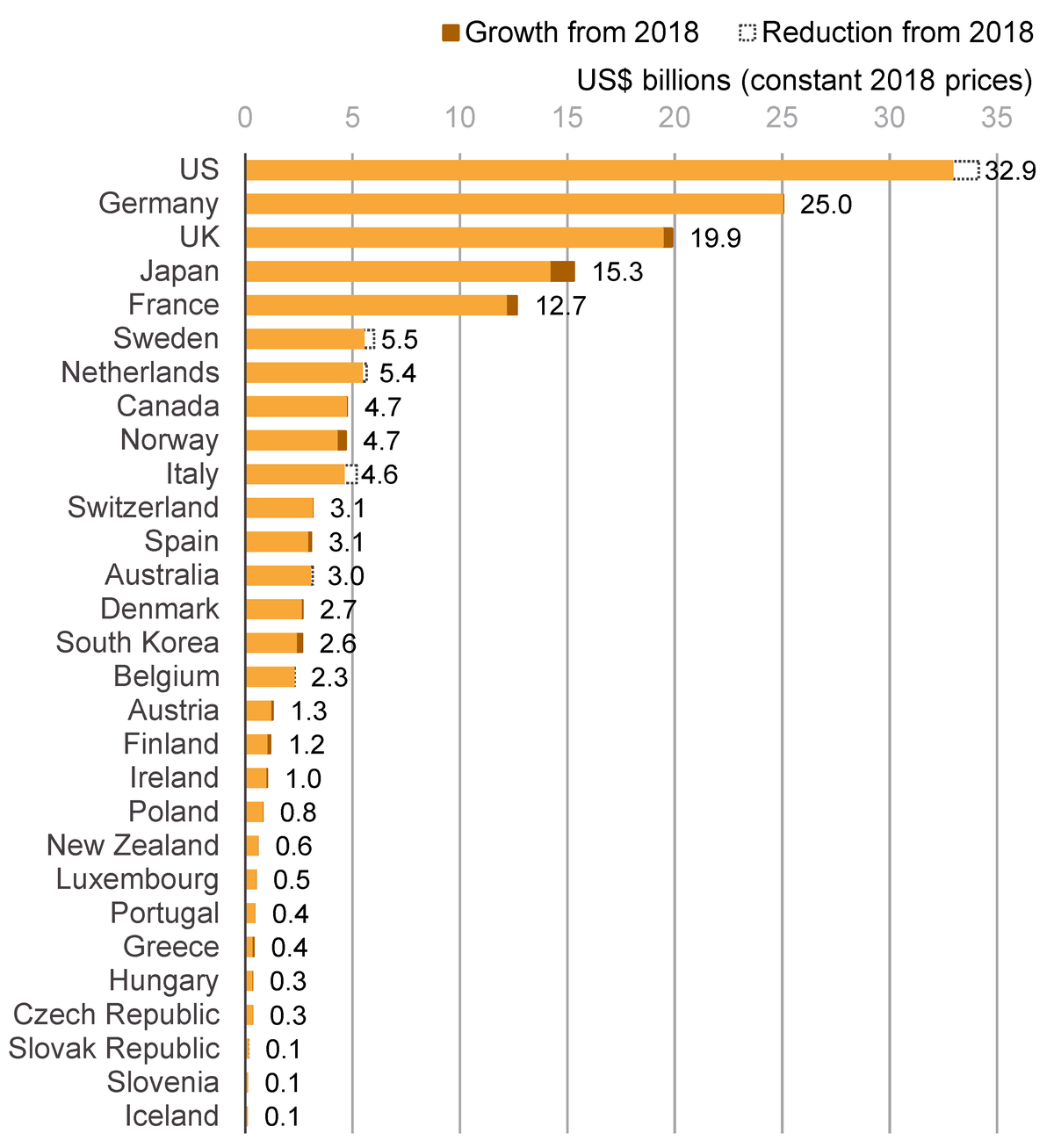
Stacked bar chart showing that DAC donors did not report major shifts in ODA between 2018 and 2019.
Source: Development Initiatives based on OECD DAC data.
Note: This chart shows grant-equivalent ODA and includes bilateral and multilateral ODA. The labels shown on the chart refer to ODA in 2019.
- Using the grant-equivalent ODA measure, ODA rose in 21 DAC members and fell in 8 between 2018 and 2019.
- The largest increases in cash terms were reported by Japan (US$1.1 billion), France (US$551 million) and the UK (US$448 million). Japan’s increase was driven entirely by loans and equity investments. The largest percentage increases were in Greece (32%), Finland (19%) and Hungary (13%).
- The largest falls, in cash terms, were reported by the US (US$1.2 billion), Italy (U$606 million) and Sweden (US$492 million).
Covid-19
Effects of the pandemic on aid
The effects of the pandemic have seen significant declines in ODA commitments from many bilateral donors in 2020. Seven of the thirteen bilateral donors included in the analysis of IATI data have recorded falls in ODA commitments, with four seeing reductions of 40% or more. A significant absolute fall in 2020 is particularly notable for the UK at US$5.6 billion (47%).
IDA and UNICEF are the most important drivers of ODA growth for multilaterals and IFIs in 2019
Figure 6: 10 largest donors of ODA among IFIs and multilateral organisations in 2019, and changes in disbursements, 2018–2019
Data labels give 2019 volumes
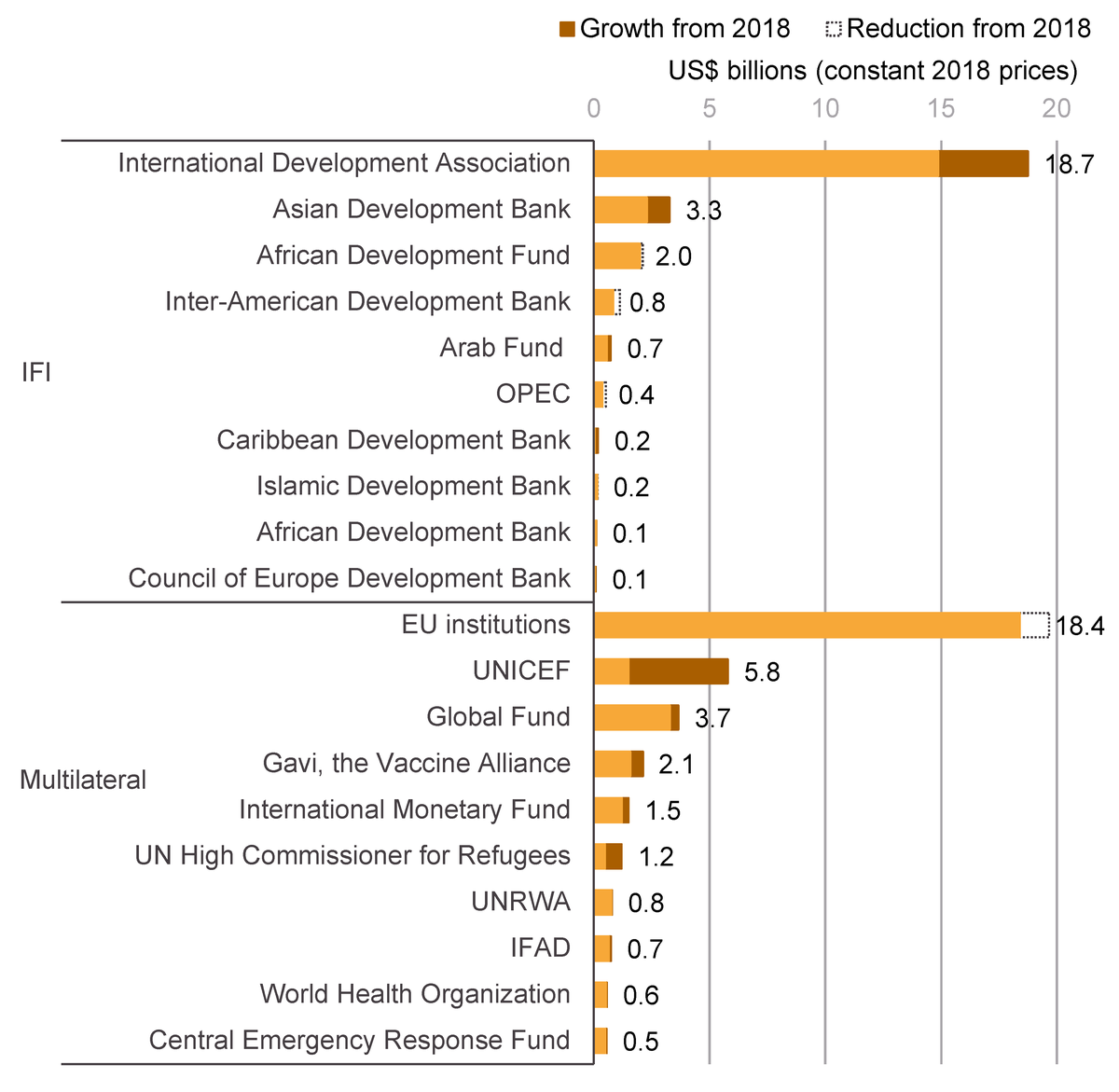
Stacked bar chart showing that IDA and UNICEF were the most important drivers of ODA growth for multilaterals and IFIs in 2019.
Source: Development Initiatives based on data from the OECD DAC.
Notes: The data in this chart refers to the expenditure of unearmarked funds from multilateral organisations. Arab Fund = Arab Fund for Economic and Social Development; IFAD = The International Fund for Agricultural Development; OPEC = Organization of the Petroleum Exporting Countries; UNRWA = United Nations Relief and Works Agency for Palestine Refugees in the Near East. The labels shown on the chart refer to ODA in 2019.
- Among IFIs, IDA increased the volume of its ODA disbursements by the largest amount in 2019, with a US$3.9 billion increase from 2018 (US$14.9 billion to US$18.7 billion).
- The largest volume decrease was recorded by the Inter-American Development Bank, where levels fell from US$1.1 billion to US$842 million over the same period.
- Among multilateral organisations, UNICEF increased the volume of its unmarked expenditure by the largest amount between 2018 and 2019, with levels growing almost fourfold (US$4.3 billion) from US$1.5 billion to US$5.8 billion.
- EU institutions were the only organisations within the largest 10 multilateral donors to decrease ODA in 2019, with a US$1.3 billion decrease from the previous year.
Covid-19
Effects of the pandemic on aid
IFIs were responsible for a significant overall increase in ODA disbursements in 2020 compared to 2019, countering the drop from bilateral donors. IFI commitments also grew substantially in 2020. This was driven by increases from the World Bank and the Asian Development Bank in particular, who increased ODA commitments by US$18.7 and US$17.6 billion respectively – amounts focused largely on Covid-19 response activities.
Limited data from multilateral organisations shows a modest 1.9% increase in commitments, the vast majority of which is concessional ODA.
It is worth noting, however, that these increases are unlikely to be sustainable in the long term, or even the short-to-medium term, without substantial recapitalisation or replenishment from bilateral donors, which seems unlikely in the current context as economies in donors countries continue to be affected by the Covid-19 crisis.
Sector and policy focus of ODA
Humanitarian assistance represented the most significant increase in ODA across sectors in 2019 at US$5 billion
Figure 7: Changes in volumes of ODA by sector, 2018–2019
Data labels give 2019 volumes
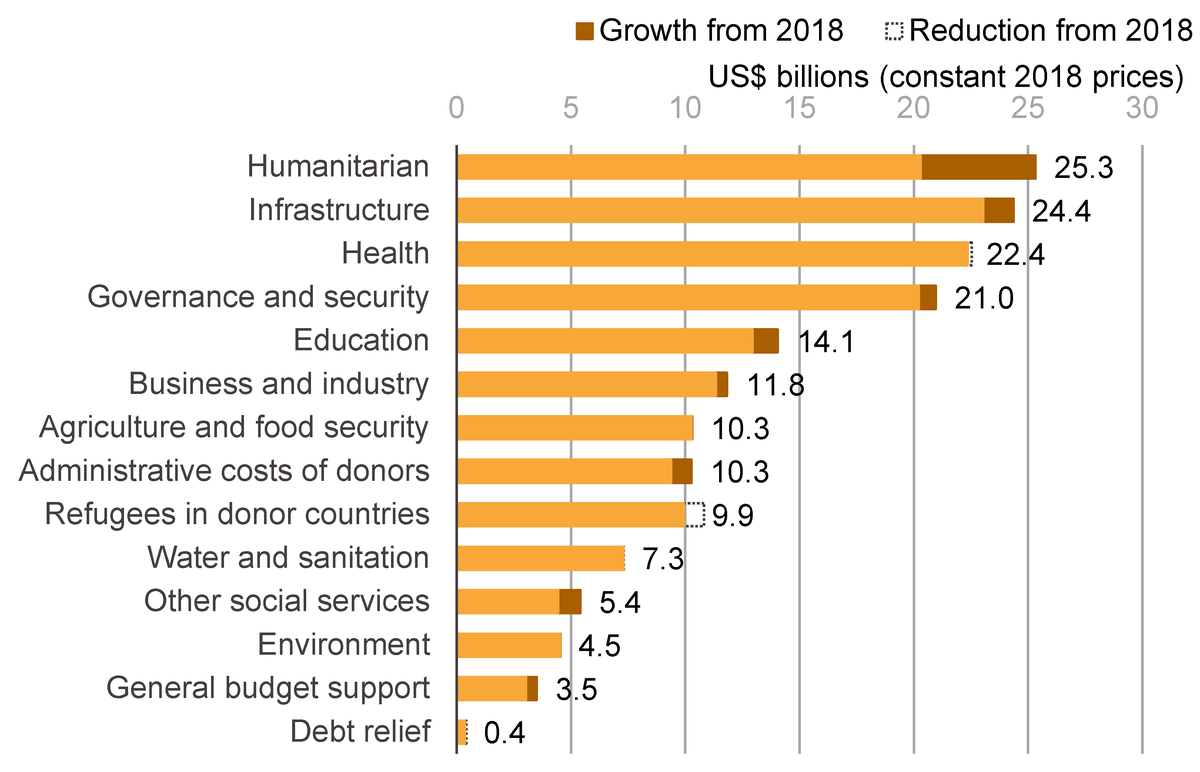
Stacked bar chart showing that humanitarian assistance represented the most significant increase in ODA across sectors in 2019 at US$5 billion.
Source: Development Initiatives based on data from the OECD DAC.
Note: The labels shown on the chart refer to ODA in 2019.
- The three sectors with the largest volume increases between 2018 and 2019 were the humanitarian, infrastructure and education sectors, which increased by US$5 billion (25%), US$1.3 billion (6%) and US$1.1 billion (9%) respectively.
- ODA to health marginally decreased over the same period. Levels fell by 0.8% to US$22.4 billion. This fall was driven predominantly by a US$2.2 billion decrease in ODA to STD control (including HIV/AIDS). ODA to basic health areas, including malaria control and infectious disease control, increased by US$1.8 billion.
- ODA to governance and security grew by 3.7% between 2018 and 2019, partly driven by increases in aid focused on the facilitation of orderly and safe migration and mobility, domestic revenue mobilisation and ending violence against women and girls.
- Refugee hosting costs saw the largest volume and percentage decrease between 2018 and 2019, with levels falling by 8% from US$10.8 billion to US$9.9 billion.
- ODA to other social services grew by 22% over the same period, from US$4.4 billion to US$5.4 billion.
IFIs played a more important role in financing governance and security, social protection and education in 2020, while bilateral donors protected health spending at the expense of other sectors
Figure 8: Changes in allocation of aid by sector, January–November during 2019–2020
Data labels give 2020 volumes
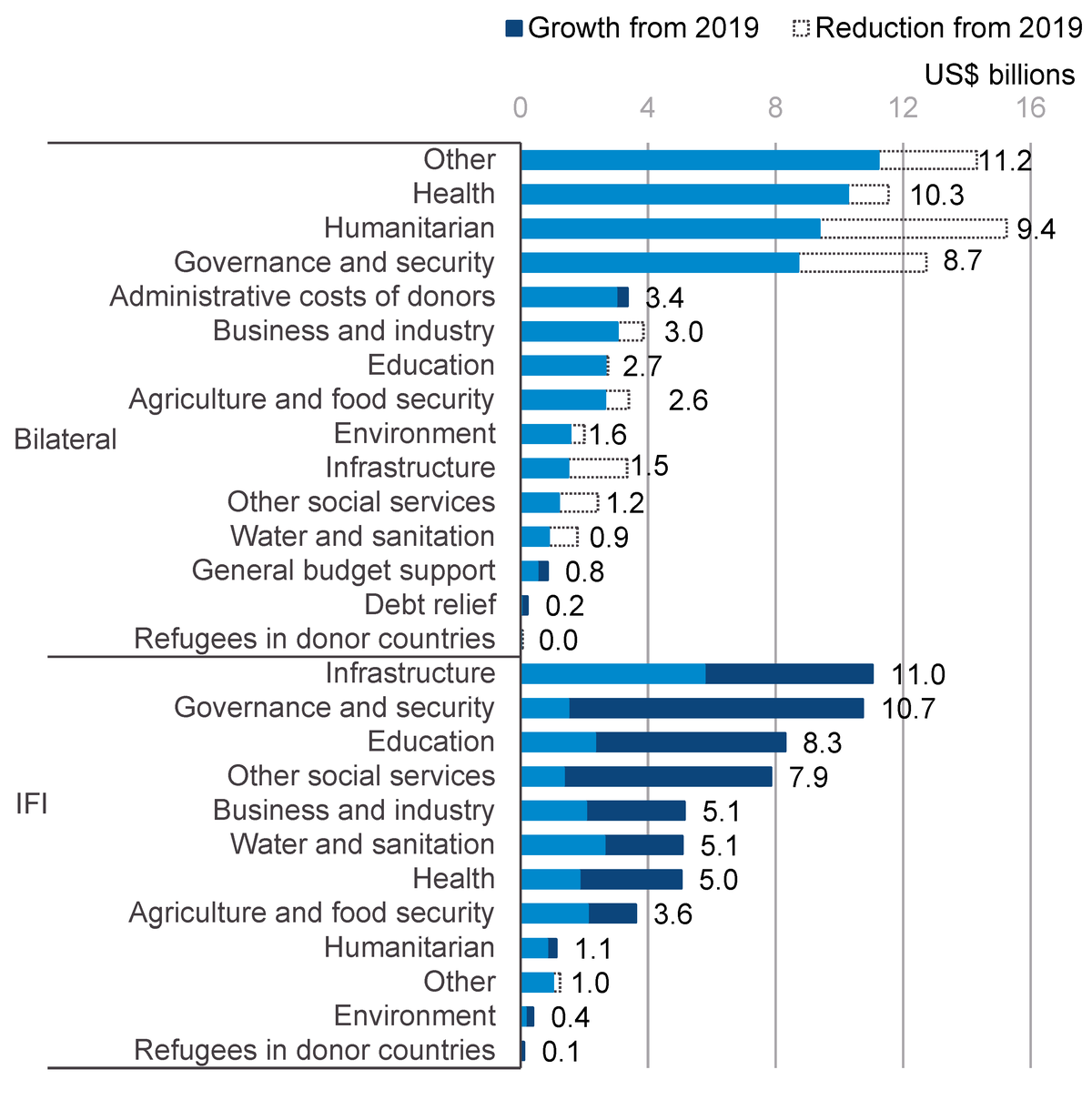
Stacked bar chart showing that IFIs played a more important role in financing governance and security, social protection and education in 2020, while bilateral donors protected health spending at the expense of other sectors.
Source: Development Initiatives based on IATI data.
Note: ‘Other’ includes: ‘Other Multisector’, ‘Other Commodity Assistance’ and ‘Unallocated/Unspecified activities.’
- During the Covid-19 pandemic, bilateral donors have roughly maintained commitments to health, while most other sectors have seen cuts, including humanitarian, and governance and security sectors.
- IFIs have increased ODA volumes committed to all sectors, most notably social protection. This has been driven by the World Bank and Asian Development Bank, which accounted for the vast majority of the US$6.5 billion increases in the wider ‘other social infrastructure and services’ reporting category.
ODA focused primarily on promoting gender equality declined slightly between 2015 and 2019
Figure 9: Percentage of ODA using the policy marker for gender equality, 2015–2019

Stacked percentage bar chart showing that ODA focused primarily on promoting gender equality declined slightly between 2015 and 2019.
Source: Development Initiatives based on OECD DAC data.
Note: This chart includes bilateral allocable ODA only.
- The proportion of bilateral allocable ODA marked as having gender equality as either a ‘principal’ or ‘significant’ focus increased from 34% in 2015 to 42% in 2019. However, the share of this which is marked as having a ‘principal’ focus on gender equality decreased marginally from 5% in 2014 to 4.7% in 2019.
- The largest volume increases in ODA focused on gender equality by individual donors between 2018 and 2019 came from the US (US$1 billion or 18%), Japan (US$847 million or 26%) and France (US$363 million or 26%).
- ODA focused on gender equality from Australia fell by US$477 million (37%) between 2019 and 2018, while Canada’s fell by US$183 million (8%) over the same period.
Covid-19
Effects of the pandemic on aid
The Covid-19 crisis has exposed and exacerbated gender inequalities , especially in the economic and social consequences of the pandemic, with women making up 70% of the health and social care workforce globally and thus being exposed to greater risk of infection. Women have less access to social protection, are more likely to be in fragile employment and are disproportionately responsible for unpaid care and domestic work which has increased during the pandemic. Increased gender-based violence, female poverty and greater difficulty accessing sexual and reproductive health services have all further worsened the gender equality gap .
Tackling this increasing need is a critical consideration for ODA donors in 2021. Analysis of IATI data that uses the gender policy marker in 2019–2020 shows a mixed trend.
For the select group of bilateral donors with sufficient data quality, the proportion of aid to projects with a significant element promoting gender equality dropped from 58% in 2019 to 55% in 2020. Despite proportions of commitments to projects with a principal component promoting gender equality increasing from 8% to 10%, the proportion of projects not considering gender has increased slightly.
The share of ODA focused on climate change reached an all-time high in 2019
Figure 10: Percentage of ODA using climate change policy markers, 2015–2019

Stacked percentage bar chart showing that the share of ODA focused on climate change reached an all-time high in 2019.
Source: Development Initiatives based on OECD DAC data.
Notes: This chart shows aid reported under both the climate mitigation and climate adaptation markers. It includes bilateral allocable ODA only.
- For DAC donors, the proportion of bilateral allocable aid marked as having climate as a ‘principal’ or ‘significant’ focus increased from 20% in 2015 to 26% in 2019. The share of this which was ‘principal’ recovered to 2017 levels, growing from 8% in 2018 to 11% in 2019. The share which was ‘significant’ has remained constant since 2018.
- ODA focused on climate mitigation and adaptation both increased between 2018 and 2019. ODA marked for climate mitigation (which was 50% higher than that marked for adaptation in 2019) increased by 15% to reach US$18.1 billion. ODA marked for climate adaptation increased by 13% to US$12.2 billion.
- The largest volume increases in ODA focused on climate change by individual donors between 2018 and 2019 came from Japan (US$1 billion or 21%), Germany (US$623 million or 12%) and France (US$601 million or 29%).
- ODA focused on climate change fell from Canada by US$160 million (31%) and from the US by US$137 million (12%).
Covid-19
Effects of the pandemic on aid
The Covid-19 pandemic risks further derailing the climate agenda as focus shifts to more short-term and domestic concerns. Even before Covid-19, funding for climate and disaster resilience was off track to reach the goals of the Paris Agreement on climate change and the Sendai Framework for Disaster Risk Reduction.
While the climate agenda has been a key focus on political discussions through the latter part of 2020 as decision-makers focus on post-pandemic recovery, this has not yet translated into an increase in funding. Rather, a slight decrease has been observed in near real-time IATI data, with the proportion of climate-focused projects returning to 2018 levels.
For the select group of bilateral donors with sufficient data quality, the share of ODA to projects with a significant focus on climate change mitigation and/or adaptation dropped from 25% to 17% between 2019 and 2020. The proportion of ODA to projects with a principal climate objective also dropped over the same period, from 18% to 14%. Projects with no targeting increased from 57% to 69%.
Targeting and allocation of aid
ODA to LDCs increased by 12% between 2018 and 2019 – the largest jump since 2012 – but was largely driven by growth in humanitarian assistance
Figure 11: Change in ODA to LDCs, non-LDCs and non-country-allocable ODA, 2010–2019
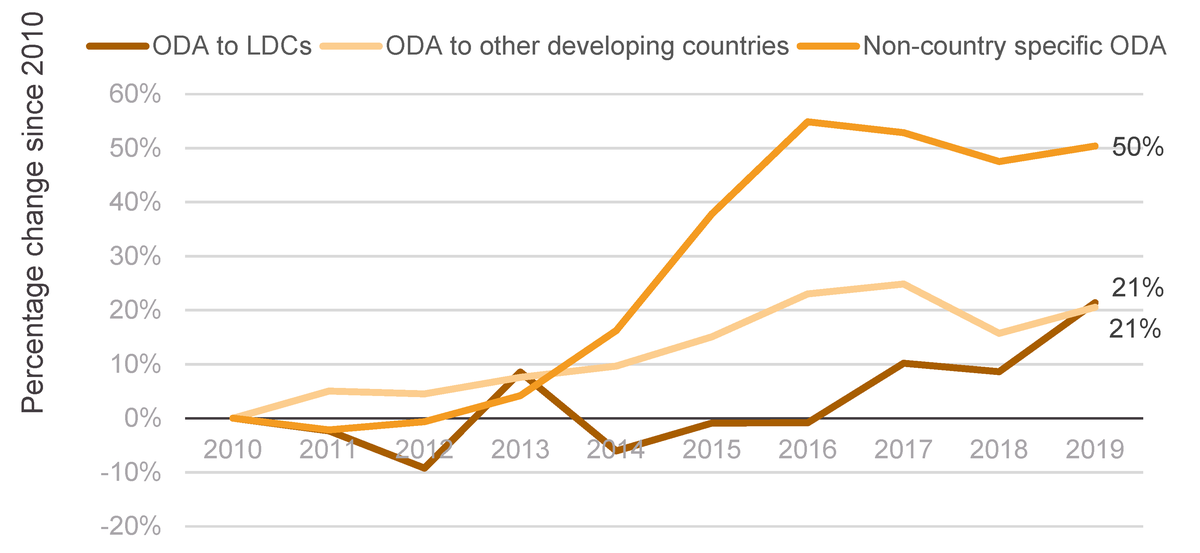
Line chart showing that ODA to LDCs increased by 12% between 2018 and 2019 – the largest jump since 2012 – but was largely driven by growth in humanitarian assistance.
Source: Development Initiatives based on data from the OECD DAC.
Note: LDCs = least developed countries.
- Total ODA to LDCs from DAC donors and multilateral organisations combined grew by 12% (US$6 billion) between 2018 and 2019 to reach US$57 billion. This was the largest single year increase in ODA to LDCs since the jump between 2012 and 2013 of US$8.4 billion. Over half of this increase was driven by increases in humanitarian assistance, and the majority by two institutions, IDA and UNICEF.
- ODA to non-LDC countries grew by US$3 billion in 2019 – a 4.2% increase when compared to 2018 levels.
- DAC bilateral donors increased ODA to LDCs by 2.8%, representing a US$788 million growth between 2018 and 2019. This increase was driven by UK and Japan, countering a significant decrease from the US.
- Multilateral organisations increased their ODA by 23%, representing a US$5.2 billion increase over the same period. IDA and UNICEF drove this shift, each increasing ODA to LDCs by US$2.5 billion between 2018 and 2019.
- The increased in ODA to LDCs from IDA continues a trend from recent years – with IDA lending to LDCs up from 29% in 2011 to 60% in 2019. Of the 10 largest recipients of ODA loans in 2019, the International Monetary Fund rated 5 as being at moderate risk of debt distress and one (Ethiopia) at high risk.
- UNICEF reported significantly more ODA in 2019, up US$4.3 billion in total, of which over half (53%) went to LDCs. By far the largest increase in LDCs from UNICEF was in humanitarian assistance, up from US$58 million to US$1.76 billion – an increase of US$1.7bn, or almost 3,000%.
- Over the last decade, ODA to LDCs grew by 21% (driven by momentum since 2016) – the same increase as for other countries. Over the same period, ODA with no specified recipient country was 50% higher in 2019 than in 2010.
Covid-19
Effects of the pandemic on aid
The effects of the economic crisis caused by the pandemic will be particularly acute for LDCs whose resilience to crises and shocks was already constrained, for whom aid represents a vital countervailing force.
Analysis of near real-time IATI aid data shows that commitments to LDCs from bilateral donors have fallen in volume terms (by US$6.4 billion) and from IFIs have fallen as a proportion (from 59% of commitments to 41% in 2020), despite the greater exposure to the shocks of the crisis caused by the pandemic.
The proportion of ODA going to countries with the highest rates of extreme poverty grew 2.3% between 2015 and 2019
Figure 12: Percentage of ODA by share of population living in extreme poverty, 2015–2019

Stacked percentage bar chart showing that the proportion of ODA going to countries with the highest rates of extreme poverty grew 2.3% between 2015 and 2019.
Source: Development Initiatives based on data from the OECD DAC and World Bank.
Notes: Percentages shown may not add up to 100% due to rounding. Bands were identified in such a way as to contain as even as possible a number of countries within them. ‘Extreme poverty’ refers to those living with an income below the international poverty line of $1.90 per day.
- The proportion of ODA going to counties where over 40% of the population live in extreme poverty (on less than $1.90 per day) has grown over the last five years from 24% to 27%. The volume of ODA to these 24 countries increased by 11% between 2018 and 2019 to reach US$33.6 million.
- Within this group, the share of ODA to countries with the highest rates of extreme poverty (over 50% of the population) has increased by 38% over the last five years. ODA to these 12 countries grew 17% between 2018 and 2019.
- However, for countries where between 25% and 40% of the population live in extreme poverty, the proportion of ODA directed to them has not changed over the last five years. The volume of ODA to this group of countries declined between 2015 and 2018, before rising in 2019.
- The proportion of ODA to countries with the lowest rates of extreme poverty (between 0% and 0.5% of the population) peaked in 2016 at 15%, before declining to 13% in 2019, returning to 2015 levels.
The share of ODA going to low-income countries remains unchanged
Figure 13: Percentage of ODA by country income group, 2010–2019

Stacked percentage bar chart showing that the share of ODA going to low-income countries remains unchanged.
Source: Development Initiatives based on data from the OECD DAC and World Bank.
Notes: Percentages may not add up to 100% due to rounding.
- The share of ODA going to LICs has remained fundamentally unchanged over the last decade, falling slightly from a high of 37% of total ODA in 2010 to 35% in 2019.
- Similarly, the proportion of ODA going to lower middle-income countries (LMICs) has remained the same, at 44% of total ODA in both 2010 and 2019, while ODA to upper middle-income countries (UMICs) has varied slightly more over the decade but has remained at roughly one-fifth of total ODA.
Low-income countries did not see an increase in ODA commitments from bilateral donors or IFIs as the Covid-19 pandemic hit in 2020
- The proportion of bilateral ODA commitments going to LICs has stayed constant between 2019 and 2020. However, there has been a slight shift in commitments away from UMICs and towards LMICs.
- Over the same period, IFIs commitments remain focused on middle-income countries, particularly LMICs. LICs have benefited less from the increase in IFI commitments. This trend is mirrored in overall ODA, which has decreased to LICs in favour of middle-income countries.
- IFI commitments to LICs decreased by 19% between 2019 and 2020, which is nonetheless a US$3.9 billion increase in volume terms due to the significant increases in commitments from IFIs in 2020. Between 2019 and 2020, commitments to UMICs and LMICs grew from 3% to 14% and 56% to 64% respectively, equivalent to increases of US$24.6 billion and US$7.1 billion in volume terms.
- Collectively, bilateral donors have maintained the proportion of ODA going to countries where more 20% of the population live in extreme poverty, at 51%.
- IFIs reduced the proportion of ODA going to countries with the highest rates of extreme poverty (over 20% of the population), from 53% in 2019 to 33% in 2020, and increased the proportion to countries with lower rates of extreme poverty (less than 5%), from 23% to 41% over the same period.
- Bilateral donors have maintained their commitments to LDCs at roughly half of bilateral country-allocable ODA. However, this represents a drop in volume terms of US$6.4 billion.
- The proportion of IFI commitments going to LDCs reduced from 59% in 2019 to 41% in 2020.
10 of the 15 largest recipients of ODA saw increases between 2018 and 2019
Figure 16: Changes in volumes of ODA for 15 largest recipients, 2018–2019
Data labels give 2019 volumes
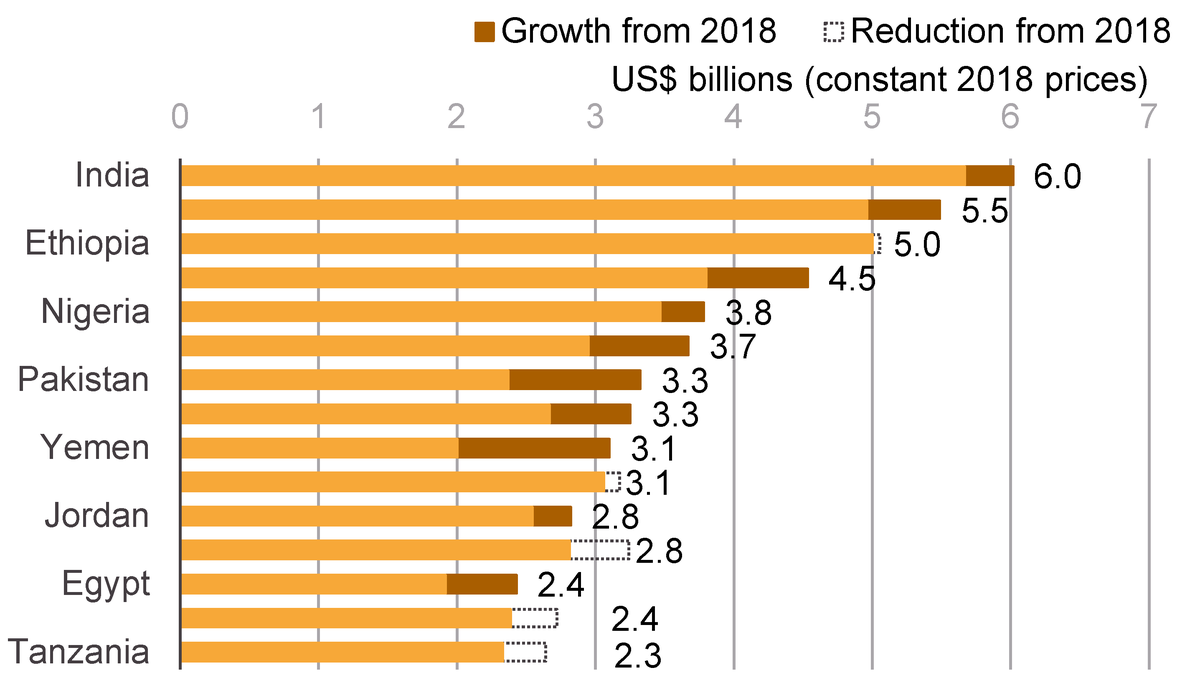
Stacked bar chart showing that 10 of the 15 largest recipients of ODA saw increases between 2018 and 2019.
Source: Development Initiatives based on data from the OECD DAC.
Note: DRC = Democratic Republic of the Congo. Data labels refer to 2019 data.
- 10 of the 15 largest recipients of ODA in 2019 saw increases between 2018 and 2019, whilst 5 saw decreases.
- Humanitarian assistance grew in 12 of the 15 largest recipients over the same period. In the Democratic Republic of the Congo (DRC) and Yemen, humanitarian assistance drove close to three-quarters of overall increases.
- Yemen received the largest increase in ODA, at just over US$1 billion. Conversely, Turkey received US$429 million less in 2019 than they did in 2018 – the largest fall for any of the fifteen countries listed.
- 8 of the 15 countries experienced a growth in ODA of 10% or higher in 2019 compared to 2018 levels. Of these, five countries experienced increases greater than 20%: Yemen (55%), Pakistan (40%), Egypt (26%), Kenya (24%) and DRC (22%).
- 3 of the 15 countries experienced decreases of more than 10% in ODA between 2019 and 2019: Turkey (13%), Vietnam (13%) and Tanzania (12%).
Covid-19
Effects of the pandemic on aid
The significant overall changes in aid in 2020, seen in IATI data up to November, have had different effects for individual countries. 85 low- and middle-income countries have seen a decrease in commitments in 2020; of these, 48 countries have observed a decrease of greater than a quarter. In contrast, 48 countries have seen an increase in commitments in 2020; of these, 31 countries have seen an increase greater than a quarter.
Appendix
Table A1: ODA commitments by key bilateral donors, IFIs and multilateral organisations (January–November during the years 2019–2020)
| Donor | 2019 (US$ millions) | 2020 (US$ millions) |
|---|---|---|
| Bilateral | ||
| Belgium | 1,005 | 2,880 |
| Canada | 2,074 | 1,092 |
| Denmark | 1,273 | 1,302 |
| European Commission | 9,402 | 9,393 |
| Germany | 6,226 | 2,254 |
| Netherlands | 3,722 | 1,885 |
| New Zealand | 93 | 281 |
| Norway | 2,364 | 3,152 |
| Spain | 291 | 230 |
| Sweden | 2,671 | 3,076 |
| Switzerland | 1,130 | 1,283 |
| UK | 11,976 | 6,403 |
| US | 31,595 | 21,201 |
| IFI | ||
| African Development Bank Group | 5,054 | 9,477 |
| Asian Development Bank | 3,000 | 20,637 |
| Inter-American Development Bank | 224 | 370 |
| World Bank | 13,322 | 31,989 |
| Multilateral | ||
| Global Fund | 2,941 | 2,680 |
| UNICEF | 4,992 | 4,984 |
| World Food Programme | 6,356 | 6,853 |
Source: Development Initiatives based on IATI data.
Notes: Asian Development Bank committed US$9.8 billion of other official flows in 2019, compared to only US$0.2 billion in 2020. The European Bank for Reconstruction and Development and International Finance Corporation have no reported ODA commitments for 2019 or 2020.
Downloads
Notes
-
1
Slide deck summarising the 2020 Financing for Sustainable Development Report by the Inter-agency Task Force on Financing for Development. Available at: https://developmentfinance.un.org/sites/developmentfinance.un.org/files/FSDR%202020%20slides_0.pdf . The full report is available at: https://developmentfinance.un.org/fsdr2020Return to source text
-
2
IMF, 2020. World Economic Outlook, October 2020: A Long and Difficult Ascent. Available at https://www.imf.org/en/Publications/WEO/Issues/2020/09/30/world-economic-outlook-october-2020Return to source text
-
3
Development Initiatives, 2020. Adapting aid to end poverty: Delivering the commitment to leave no one behind in the context of Covid-19. Chapter 3. Available at: /resources/adapting-aid-to-end-poverty/worsening-poverty-landscape-covid-19/Return to source text
-
4
Development Initiatives, 2020. Adapting aid to end poverty: Delivering the commitment to leave no one behind in the context of Covid-19. Chapter 3. Available at /resources/adapting-aid-to-end-poverty/covid-19-and-its-impact-financing-landscape/Return to source text
Related content
Cuts to the UK 2020 aid budget: What IATI data tells us
This briefing compares data published by the UK's FCDO and DFID in 2019 and 2020, showing where aid budget cuts fell among recipients, countries and sectors
How is aid changing in the Covid-19 pandemic?
This briefing sets out near real-time data on aid for the first half of 2020. It shows how commitments are changing in the Covid-19 pandemic and where these are most likely to affect the poorest people and places.
Adapting aid to end poverty: Delivering the commitment to leave no one behind in the context of Covid-19
This report calls for us to refocus ODA (aid) in the context of Covid-19, shifting the ‘leave no one behind’ agenda from inclusive growth to inclusive recovery. It analyses changes to poverty and how the pandemic has impacted finance vital to the poorest people.
